- Home
- Talks
- Latest Adventure
- Journey To Date
- Journey To Date
- Cruise 2017 Adventure
- Kayak Adventures 2012
- The Route du Rhum 2010
- Spirit of Mystery 2008-2009
- - Mystery Team
- - Interview with Pete Goss
- - Voyage Route
- Pete's Q&A
- North Pole 2006-2009
- Fastnet 2007
- RB&I 2006
- SeaCart 30
- Playing For Success
- Team Philips 2000
- Vendee Globe 1996/7
- British Steel Challenge 1992
- Carlsberg Translantic 1988
- Three Peaks Race 1984
- Messages of Support
- Galleries
- Articles
- Contact
-
Cruise 2017 Adventure
September 6th, 2019
BATH
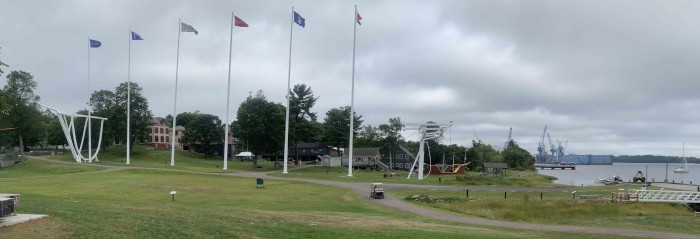
We had a lovely trip up the Kennebeck River to Bath where we had a day exploring the excellent Maine Maritime Museum. I could go on and on but we really enjoyed the section on lobster where my many questions were answered. I certainly didn't know that they could live to a hundred years of age and grow to four feet in length. Females can walk up to a hundred kilometers to their nesting site!!
The other amazing thing was the size of the ship building business so far inland. During the second world war Bath built 82 destroyers. They also built fishing boats and Harold Vanderbilts famous Americas Cup yachts Endeavour and Ranger.
As we have sailed these parts I have often reflected that the trees we are seeing are not as mature as I would have expected and the answer lies in ship building. Hundreds of huge sailing ships were built in Bath and they hoovered up woodland in the process. This picture gives you an idea of their size thanks to the life size sculpture representing the six-mast, 426ft Wyoming which could carry 6,000 tons of coal.
Bath was built around ship building and in an old sketch of the town you can see the rope works that ran right through its center. John D Smith spent 45 years spinning 64,940,666 fathoms of thread walking ten miles a day totaling a staggering 140,850 miles. Half of it backwards....the equivalent of nearly three times around the world backwards.
The picture also shows the modern and busy ship building industry that presently exists to churn out US Navy ships. That's Pearl on a mooring to the far right.
The other amazing thing was the size of the ship building business so far inland. During the second world war Bath built 82 destroyers. They also built fishing boats and Harold Vanderbilts famous Americas Cup yachts Endeavour and Ranger.
As we have sailed these parts I have often reflected that the trees we are seeing are not as mature as I would have expected and the answer lies in ship building. Hundreds of huge sailing ships were built in Bath and they hoovered up woodland in the process. This picture gives you an idea of their size thanks to the life size sculpture representing the six-mast, 426ft Wyoming which could carry 6,000 tons of coal.
Bath was built around ship building and in an old sketch of the town you can see the rope works that ran right through its center. John D Smith spent 45 years spinning 64,940,666 fathoms of thread walking ten miles a day totaling a staggering 140,850 miles. Half of it backwards....the equivalent of nearly three times around the world backwards.
The picture also shows the modern and busy ship building industry that presently exists to churn out US Navy ships. That's Pearl on a mooring to the far right.
September 3rd, 2019
RAILWAY
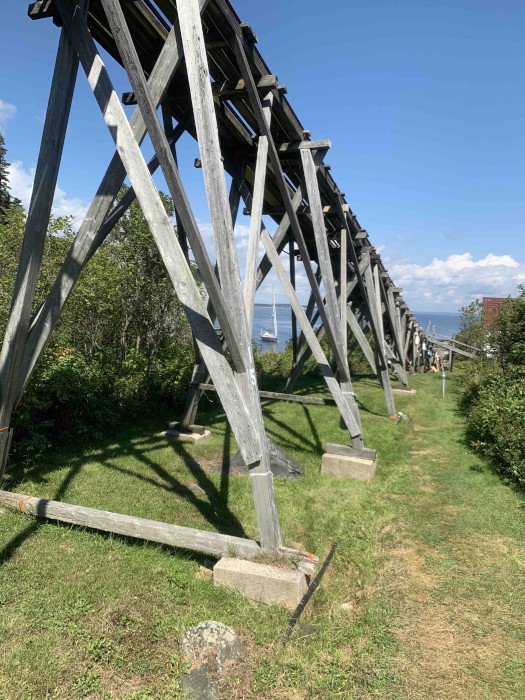
As you can see it was a pretty substantial railway which frames Pearl beautifully
September 3rd, 2019
SEGUIN LIGHTHOUSE
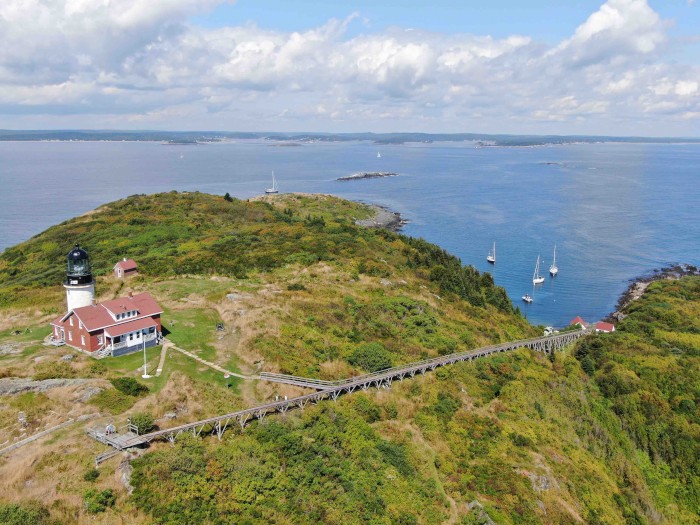
I am sat in Bath Brewery logged onto wifi to upload this blog having had a lovely day which started with a glassy morning as we motored to Seguin Island. It is a famous lighthouse and is only accessible during good weather. We just couldn't resist an unplanned stop and it didn't disappoint. Although it's still a working lighthouse the place is run by a charity with a great little museum and a volunteer takes you up to the light for some amazing views. These Lighthouses were often manned by a family and there was some lovely pictures of life on the island. They were replenished once a year with major supply from building materials to hundreds of tons of coal to run the steam fog horn. It was much more industrious than I thought with a light railway to get the coal to the top of the island. They even had a blacksmiths shop and of course a well-protected veggie garden. They hunted seal, fished and shot birds to keep food on the table.
September 3rd, 2019
THE BASIN
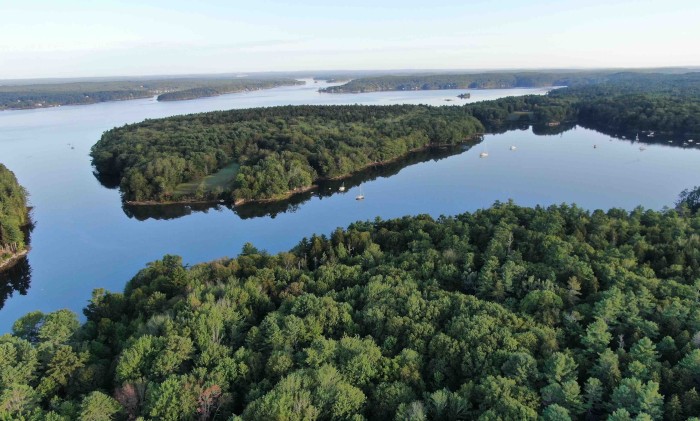
Top of our hurricane routine is make sure that on Friday we are tucked away in a hurricane hole and as you can see The Basin looks to be a good one. There are a couple of others but I think this one gets my vote.
September 3rd, 2019
HURRICANE DORIAN

This mornings cuppa in Love Cove was lovely as the sun came up to reveal a glassy surface full of reflected trees. A couple of Osprey squawked in a tree top and a Cormorant shook its wings out for the days hunt. Peaceful as it was there is a sense of foreboding in the air as our hearts go out to the lovely people of Abacos Islands battered by hurricane Dorian. Having spent a wonderful month there earlier in the year it brings a deeper sense of empathy. She is now a category five hurricane and coming our way so its with some seriousness that we follow her predicted path. It would seem that she will probably pass to our south but these monsters have a mind of their own and are often not to be predicted. A small shift in her path will liven things up for us so we have been mentally going through our hurricane routine.
September 3rd, 2019
LOVE COVE
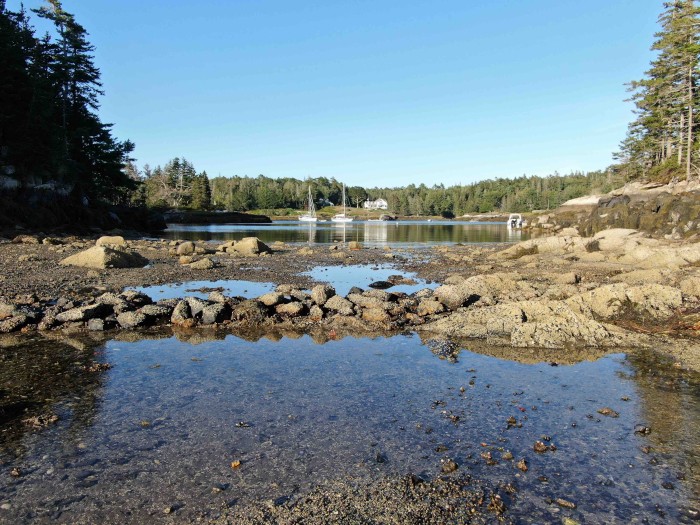
This is Love Cove and its one of the nicest places we have been. The house in the background is owned by Eliot Winslow who was a resident harbour pilot and tug tycoon. He likes to see yachts in his cove and has very generously laid some free moorings for passing cruisers.
September 3rd, 2019
FISH
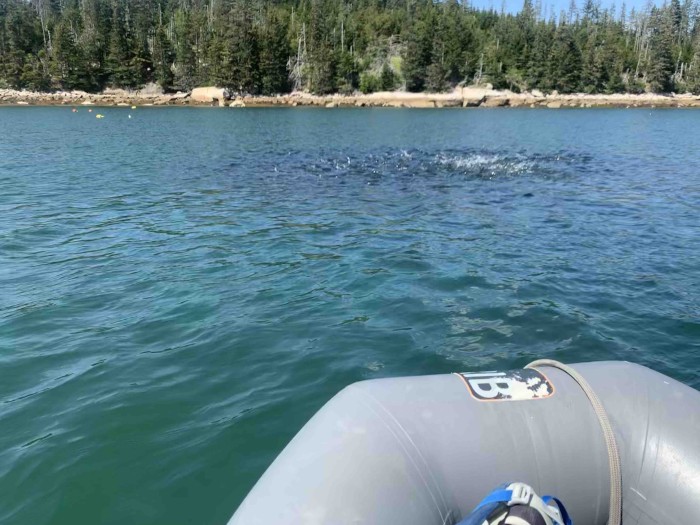
I mentioned in a previous post about great mounds of fish surging up in a heap as they are hunted from below. I missed the crucial moment but this picture captures the beginning of the heave for safety.
September 3rd, 2019
TOWNSEND GUT SWING BRIDGE
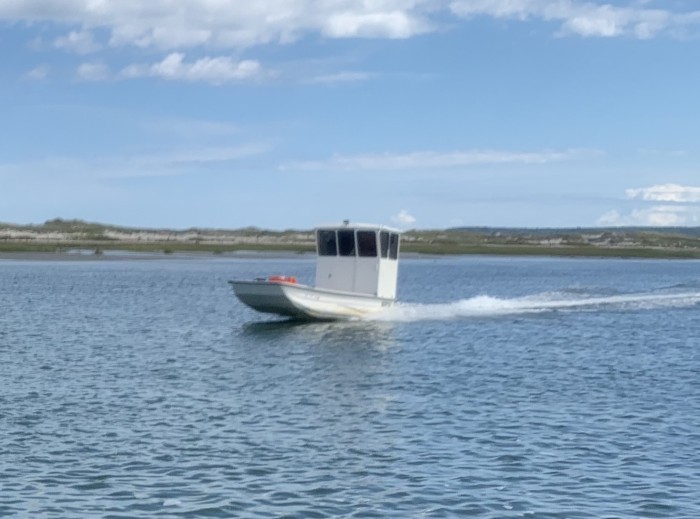
The gut calves Southport Island from the mainland and is connected by a rather lovely old swing bridge which has been run 24 hours a day seven days a week by the Lewis family for over half a century. The family have logged over 136 years of service and they are held in great store. When Ruth Lewis died they had to hold the bridge open for an hour to allow the parade of boats that came out to show their respect.

